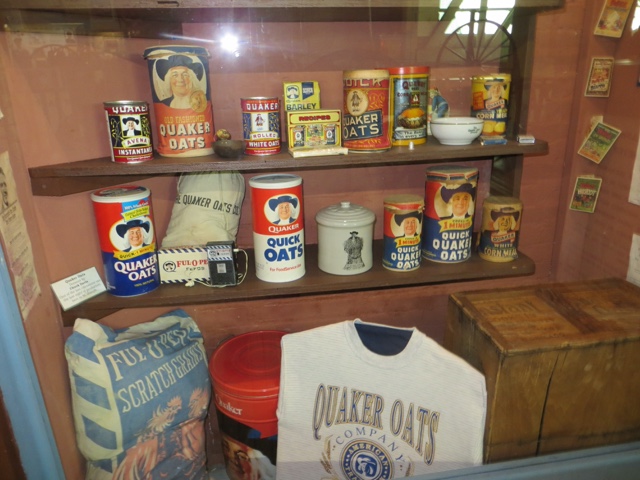By mid-afternoon, we arrived at Rusty' s house situated among the corn/soybean fields of southwestern Iowa. He was there ready with a warm welcome and plans for our visit. We spent the late afternoon catching up.
Rusty showed us around and we saw the well-placed easy chairs where we would spend our evening hours...
And the medals he has won by running 69 full marathons, two on one weekend....
And a poster that told us of a project he works on with his friends in between running, hiking and biking.
The first full day of the visit, Rusty planned to take us to St Joseph, Missouri for a visit to the Pony Express Museum, the house where Jesse James was shot, and the Patee Museum. Of course, Missouri is now state number 48!
Named one of the top ten western museums of the day, the Patee House was originally built as a hotel in 1866. It served many purposes over the years and was the official "post office " of
the Pony Express.
Many exhibits were fascinating and the museum had developed a scavenger hunt idea to help you really look at and for the items displayed. We had fun with the search! One thing we learned was that Quaker Oats had a major operation here for over 75 years here in St. Joe, MO.
Another interesting thing that seems to happen as we travel is the connecting of different parts of history in unexpected ways. For instance, in Vincennes, Ind. we found the NPS historical park dedicated to the brother of William Clark. Below is an exhibit that tells of the visits of William Seward to Mo. He was the man who helped Harriet Tubman and eventually sold her the in Auburn, NY.
It was a great day of learning. The next day would provide yet another state to visit and another big learning opportunity. Rusty took us to Nebraska City, Nebraska where we visited a Lewis and Clark Interpretation Center. Nebraska is number 49!
Merriwether Lewis had been a secretary to Thomas Jefferson and when the Louisiana Purchase was completed, Jefferson decided he wanted someone to lead a scientific exploration of the new land, mapping it to the Pacific Ocean, and noting all the species that were encountered. He chose Lewis. Lewis then wrote to his former army commander William Clark to co-lead the group. Collectively,they became known as The Corps of Discovery. Lewis has been described as a moody individual while Clark was identified as the more dependable one. Lewis took a big dog named Seaman with him, while Clark took a personal slave named York. Lewis died young, three years after the return trip in 1806, while Clark lived into old age with a wife and family. There has been much mystery around Lewis's death and many think it was a suicide. But together, they were able to inspire their men to overcome the incredible challenges they encountered like insects, weather, the topography, and the most challenging hunger.
It was amazing to me to learn that Lewis and Clark discovered and identified 173 species of plants and 134 other species that included the Grizzly Bear. Two woodpeckers that they discovered and sketched in their notes are found in our bird books of today and called the Lewis and the Clark Woodpeckers.
They also encountered over 50 different tribes and had no skirmish except one with a small band of Blackfeet. Indeed, without the help of the Clatsop, Chinook, Nez Perce, the Shoshone, the Teton Sioux, and the Mandan and the Hidatsa tribes, it is questionable that the group of over 30 people of The Corps of Discovery could have survived. But indeed the did, arriving in St. Louis on September 23, 1806, after 24 months of travel. They received a heroes welcome by the town.
The Missouri River in the background.
When we visited the western states, we had small glimpses of the history of Lewis and Clark and their expedition. We visited Fort Clatsop along the Columbia River as well as Cape Disappointment, and here learned about the second winter encampment of the journey, the aid of the Clatsop Indians and the role of the Shoshone woman, Sacajawea. We wanted to learn more about this part of history so we incorporated it into a travel theme for this trip.
I want to add a note here to clarify our travel themes mentioned above. We have no hope of thoroughly exhausting any subject like the Underground Railroad or The Trail of Tears, or to learn all the stories that make up the travels of Lewis and Clark. Our hope is to be touched by the lives of the people of this time, to be encouraged by their courage and determination, and to pay them respect and honour by visiting places that commemorate their lives and accomplishments. The blog will offer a small gleaning of what we are experiencing.
***********
The terraced fields.
Another corn field and a hard working farmer.
The Bluffs created by wind piling up the Loess soil. They extend miles through several mid-western
States along the banks of the Missouri River.
Rusty was so excited to share the Omaha Zoo trip with us on our last day. We had such a wonderful time with our friend from Alaska and Iowa. It was sad to say goodbye.
We had one last thing to do on that day before we headed for longer visits in some other states. We needed to touch base with state number 50. We crossed the border into Kansas and had a small celebration.
We did it! We had now visited all fifty states. We have pictures and postmarks to prove it! We are happy to have done it together, and thank Walmart and MacDonalds for helping us on this leg. They were always open and hospitable. We now jokingly say, you know Lewis and Clark, adventurers. Well you, also know Torrey and Ives!😀



























No comments:
Post a Comment